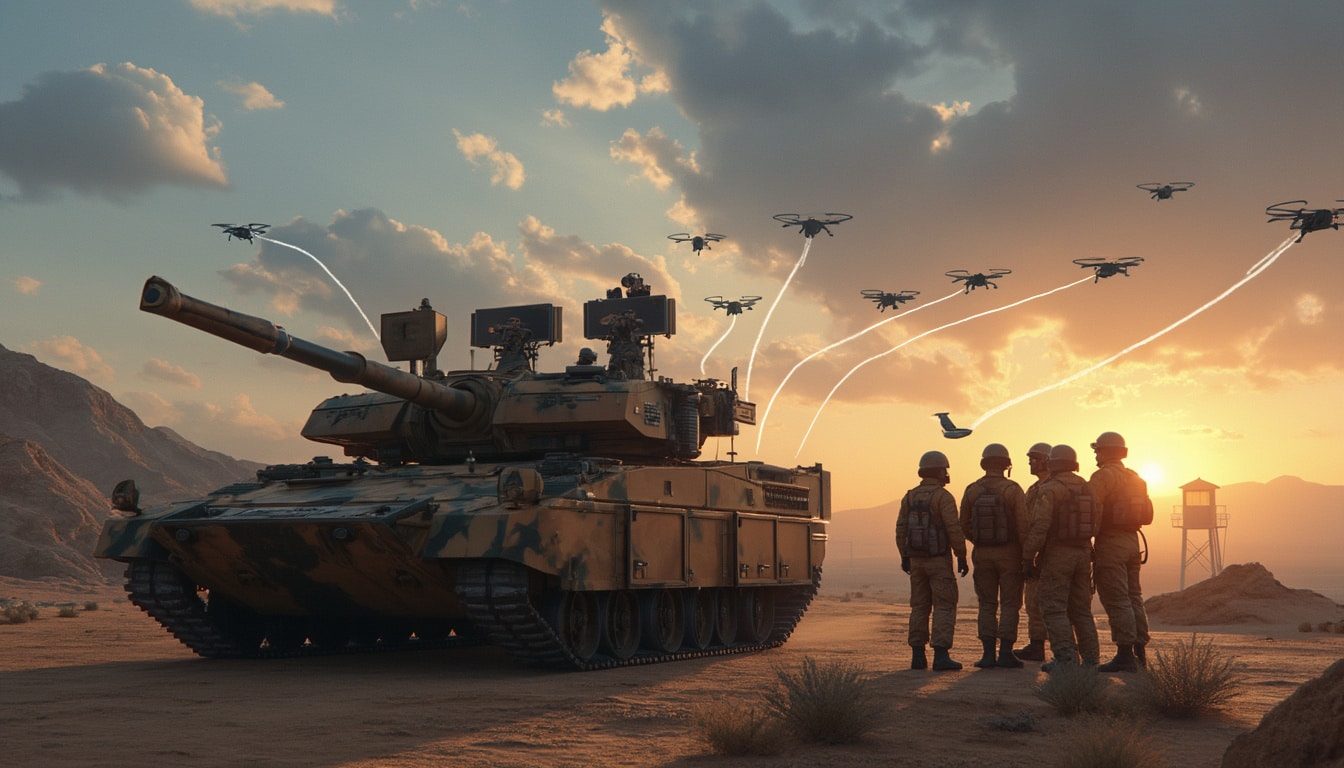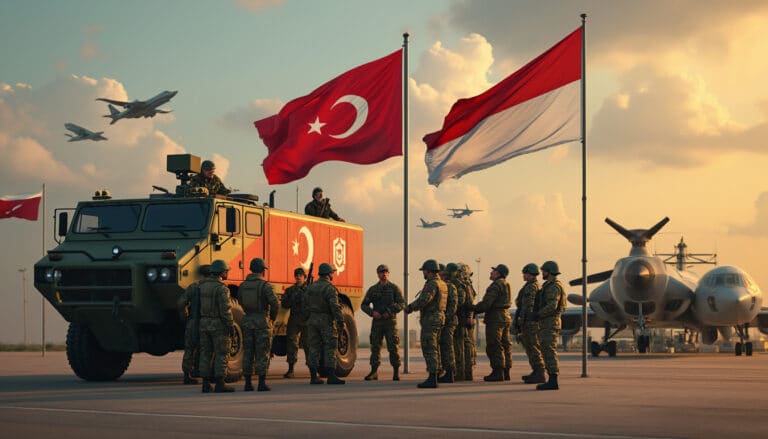The skies above Israel have recently darkened under the threatening flight of hostile drones.
In the face of this new wave of attacks, the Israeli defense forces are seeking innovative solutions.
One of the responses being considered is the adoption of the powerful M61 Vulcan cannon.
By examining this formidable weapon, the Israeli army hopes to deter and effectively neutralize drone incursions. With over 2,500 UAVs in service among groups like Hezbollah, the need for robust defense has never been more critical. The M61 Vulcan, known for its exceptional rate of fire, could become a major asset on the battlefield. This initiative is part of a broader strategy aimed at enhancing air and ground superiority in the face of emerging threats.

Table des matières
ToggleContext of Tensions between Israel and Hezbollah
The tensions between Israel and the militant group Hezbollah have intensified in recent months, marking a concerning escalation in the region. In April, Hezbollah launched a series of drones and missiles toward Israeli territory, thereby increasing the pressure on Israeli defense forces. These attacks have not only highlighted Hezbollah’s ability to mobilize advanced technologies but have also underscored the necessity for Israel to strengthen its air defenses.
According to recent reports, the Israeli-based research and education center Alma estimates that Hezbollah has over 2,500 UAVs (unmanned aerial vehicles) for various uses, ranging from intelligence gathering to direct attacks. This proliferation of drones poses a significant threat to Israel’s domestic security, particularly in the areas near the northern border where many strategic assets are deployed.
In response to this situation, the Israeli army, the Israel Defense Forces (IDF), has stepped up its efforts to detect and neutralize airborne threats. The installation of drone detection systems along the northern border is a direct response to the increase in attacks, which have risen from seven in February to twenty-four in March. Despite these measures, Hezbollah successfully sent a drone into Israeli territory in May to attack a military installation, thereby illustrating the ongoing challenges faced by Israeli defense forces.
The Growing Threat of Drones in the Conflict
The use of drones by militant groups like Hezbollah has transformed the dynamics of modern conflicts. These devices, relatively inexpensive and easy to deploy, provide valuable surveillance and attack capabilities without directly engaging human combatants. For Israel, the proliferation of Hezbollah’s drones represents a complex threat to manage, requiring advanced technological solutions and effective defense strategies.
The UAVs used by Hezbollah vary in size and function, with some designed for intelligence gathering, while others are equipped with explosive payloads for targeted attacks. This diversity allows the group to conduct a variety of operations, ranging from strategic surveillance to direct offensive actions against military and civilian targets. The ability to launch surprise attacks with drones complicates the task of Israeli defense forces, who must constantly innovate to detect and neutralize these threats.
In response to this threat, the IDF has created a dedicated unit to counter drones within its Northern Command. This unit focuses on the development and implementation of detection and interception technologies, thereby improving the speed and accuracy of responses to drone attacks. However, despite these efforts, the increasing sophistication of drones and their large numbers continue to pose significant challenges for Israeli security.
The M61 Vulcan: Features and History
The M61 Vulcan is an iconic weapon, known for its power and reliability. This electrically powered, six-barrel rotary cannon is capable of firing up to 6,000 rounds per minute, making it one of the most formidable weapons in service today. Initially developed for the U.S. military’s fighter jets, the M61 Vulcan has been utilized by the US Navy on aircraft such as the F/A-18E Super Hornet, demonstrating its effectiveness in demanding air combat environments.
Since its introduction into the Israeli Air Force in 1975, the M61 Vulcan has undergone several modifications, culminating in the Machbet variant. This improved version was deployed on armored personnel carriers known as M113 or locally as Bardehlas, until their retirement in 2006. The adaptation of the M61 Vulcan for ground use has provided the Israeli army with an effective mobile air defense weapon capable of quickly responding to drone threats.
The robustness and high rate of fire of the M61 Vulcan make it particularly suited to intercept fast and small targets like drones. Its long service history and the numerous technological improvements it has undergone testify to its ability to adapt to evolving threats and military needs.
Israel Considers Using the M61 Vulcan Against Drones
In the face of increasing drone attacks orchestrated by Hezbollah, Israeli defense forces are exploring new solutions to counter this threat. One of the options being considered is the reintroduction of the M61 Vulcan on armored vehicles, thus providing a powerful and mobile air defense capability in the long term. The idea is to mount this rotary cannon on armored personnel carriers, thereby allowing effective protection against drone incursions into sensitive areas.
The use of the M61 Vulcan represents a bold yet potentially effective strategy to neutralize enemy drones before they reach their targets. With its high rate of fire, the M61 Vulcan could intercept several drones simultaneously, thereby reducing the risk of successful attacks. Moreover, the mobility offered by its deployment on armored vehicles would allow for quick repositioning of defense units based on tactical needs on the ground.
However, this initiative requires thorough testing to evaluate the feasibility and effectiveness of the M61 Vulcan in this new role. According to an IDF spokesperson, the M61 Vulcan is currently in the testing phase alongside other solutions as part of a program aimed at strengthening Israel’s military power. It is essential to ensure that this weapon can be used safely and effectively against agile, mobile aerial targets.
Current Solutions and Israeli Defense Strategies
In addition to exploring the M61 Vulcan, the IDF is already deploying several solutions to counter the drone threat. Among these, drone detection systems serve as the first line of defense. These systems, scattered along the northern border, utilize advanced technologies to identify and track UAVs. Once a threat is detected, interception measures can be quickly undertaken using automated or manual anti-air systems.
Among the Israeli defense companies developing anti-drone solutions are Rafael Advanced Defense Systems and Israel Aerospace Industries. These companies work on various technologies, ranging from electronic jamming systems to kinetic weapons capable of destroying drones in flight. Although these companies have not directly commented on the use of the M61 Vulcan, their role in developing countermeasure technologies is crucial to Israel’s overall defense strategy.
Furthermore, the IDF has established a specialized unit within its Northern Command specifically dedicated to combating drones. This unit aims to coordinate efforts for detection, analysis, and interception of UAVs, thereby improving the rapid response capability to emerging threats. The goal is to create an integrated system where rapid detection translates into coordinated action to neutralize drones before they reach critical targets.
In addition to technological systems, the IDF is also investing in training and developing the skills of its operators. Effective defense against drones requires not only sophisticated equipment but also tactical and operational expertise to anticipate, identify, and respond to threats effectively.
Future Perspectives and Developments
As Israel continues to face the growing threat of drones from Hezbollah, exploring and adopting innovative solutions like the M61 Vulcan could play a decisive role in securing borders and strategic infrastructures. In the long run, integrating rotary cannons with air defense capabilities could enhance Israel’s resilience against asymmetric and hybrid attacks.
Moreover, technological advancements in the field of drones and aerial defense systems require constant adaptation of military strategies. The IDF must not only rely on existing weapons like the M61 Vulcan but also invest in research and the development of new detection and interception technologies. The goal is to create a comprehensive and adaptable defense ecosystem capable of responding to diverse and evolving threats.
Additionally, cooperation with international defense industries could provide Israel with access to new technologies and tactical innovations. By collaborating with strategic partners, the IDF can benefit from ongoing advancements in cybersecurity, artificial intelligence, and autonomous systems, thereby enhancing its ability to proactively anticipate and counter threats.
In conclusion, exploring the use of the M61 Vulcan to counter drones is part of a broader strategy aimed at strengthening Israeli air defense. By combining powerful weapons with advanced detection systems and effective operational coordination, Israel hopes not only to neutralize current threats but also to anticipate and prepare for future challenges posed by the rapid evolution of aerial warfare technologies.






















